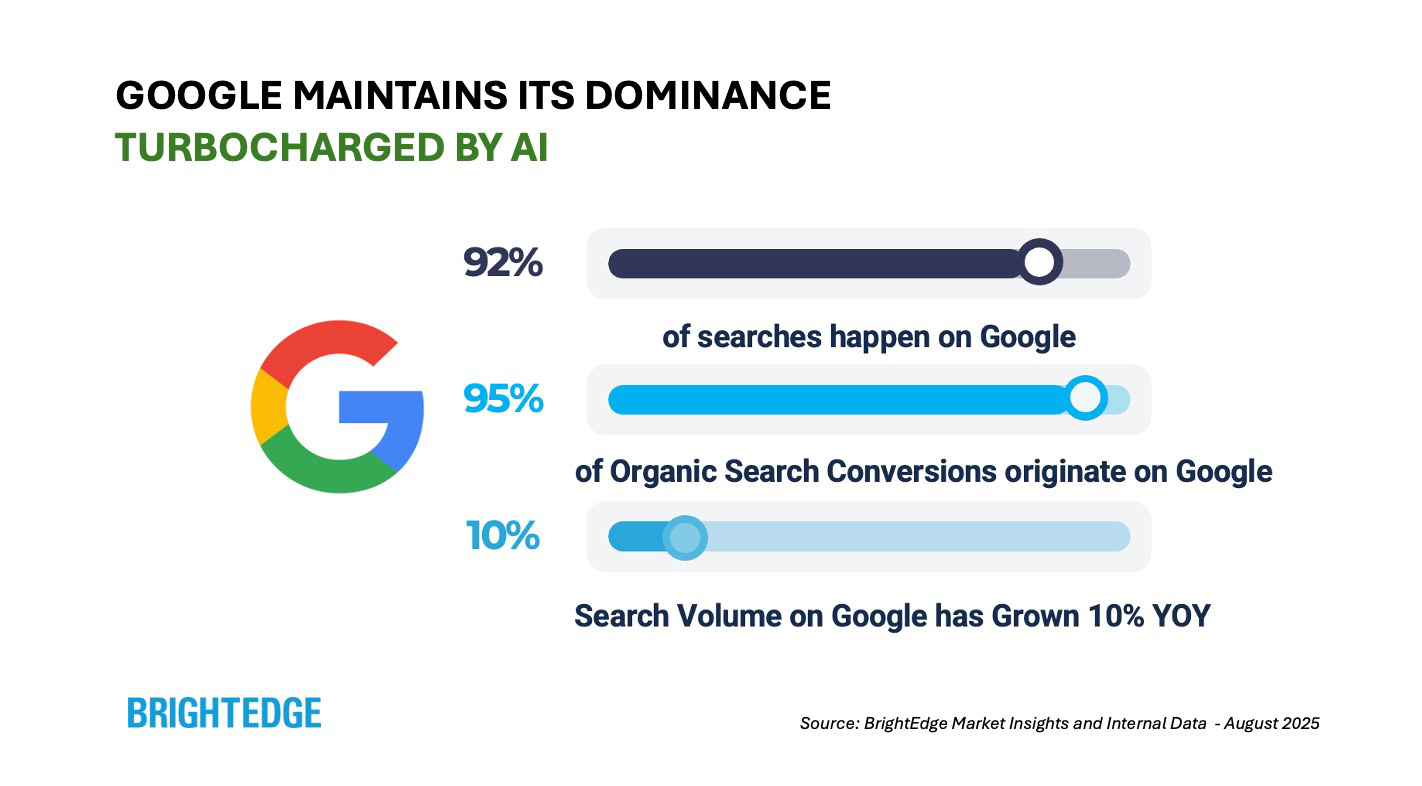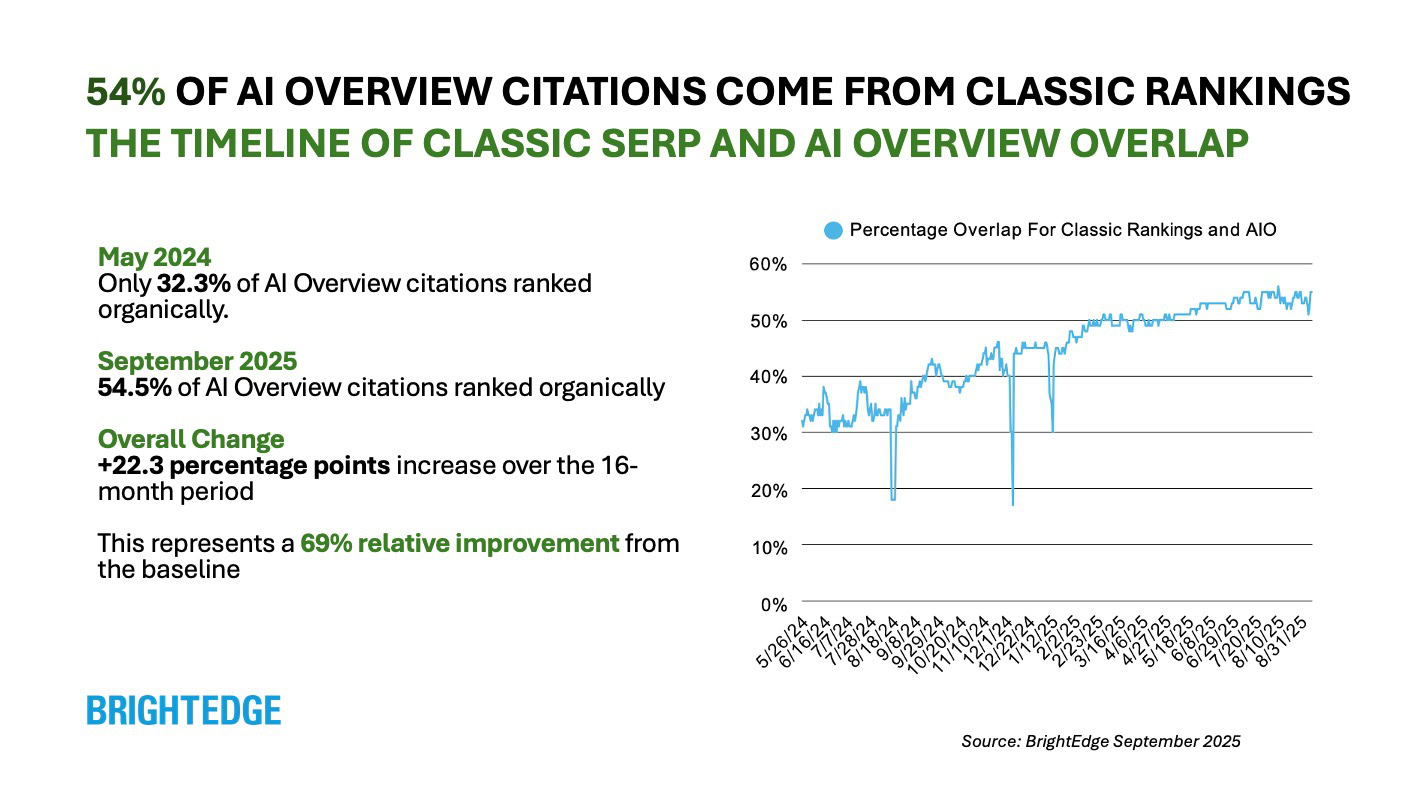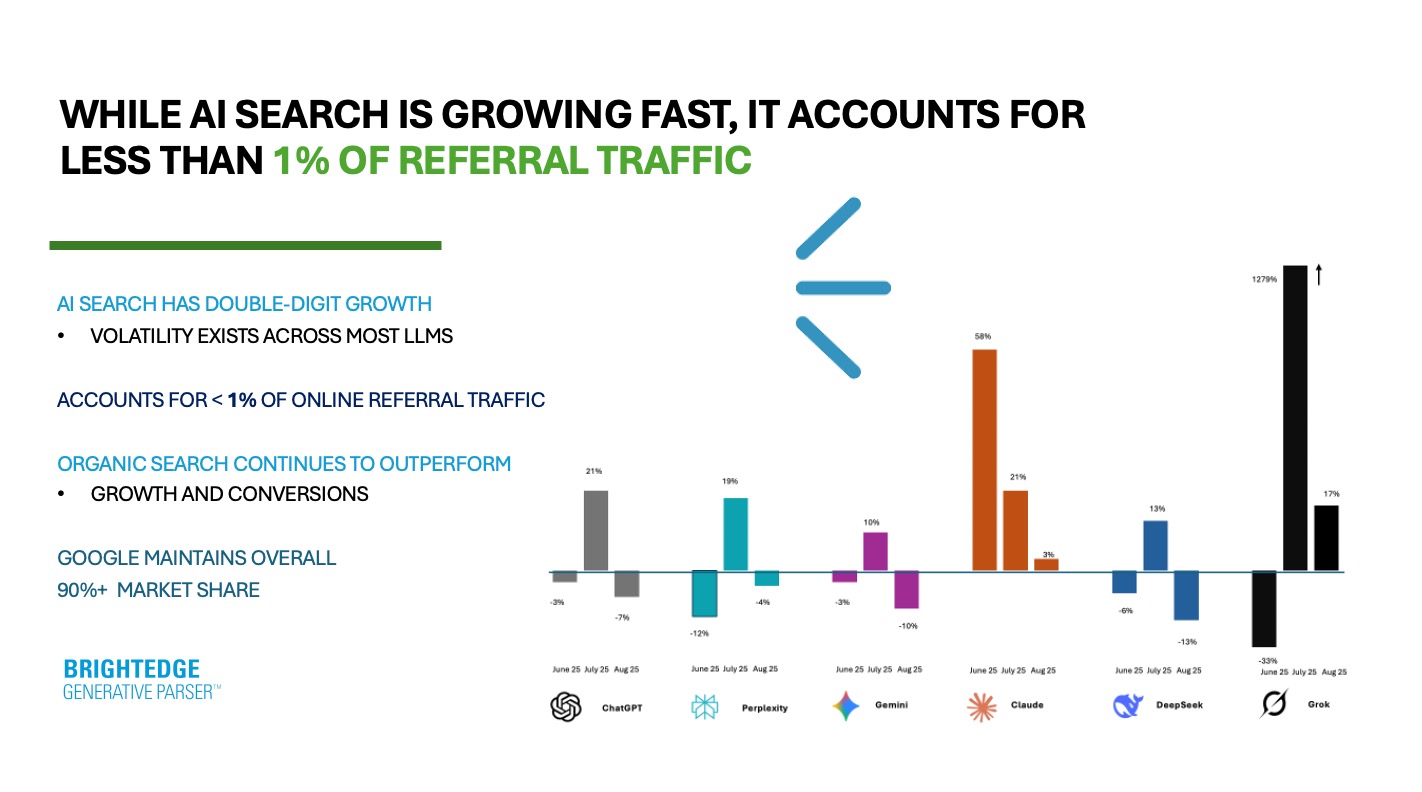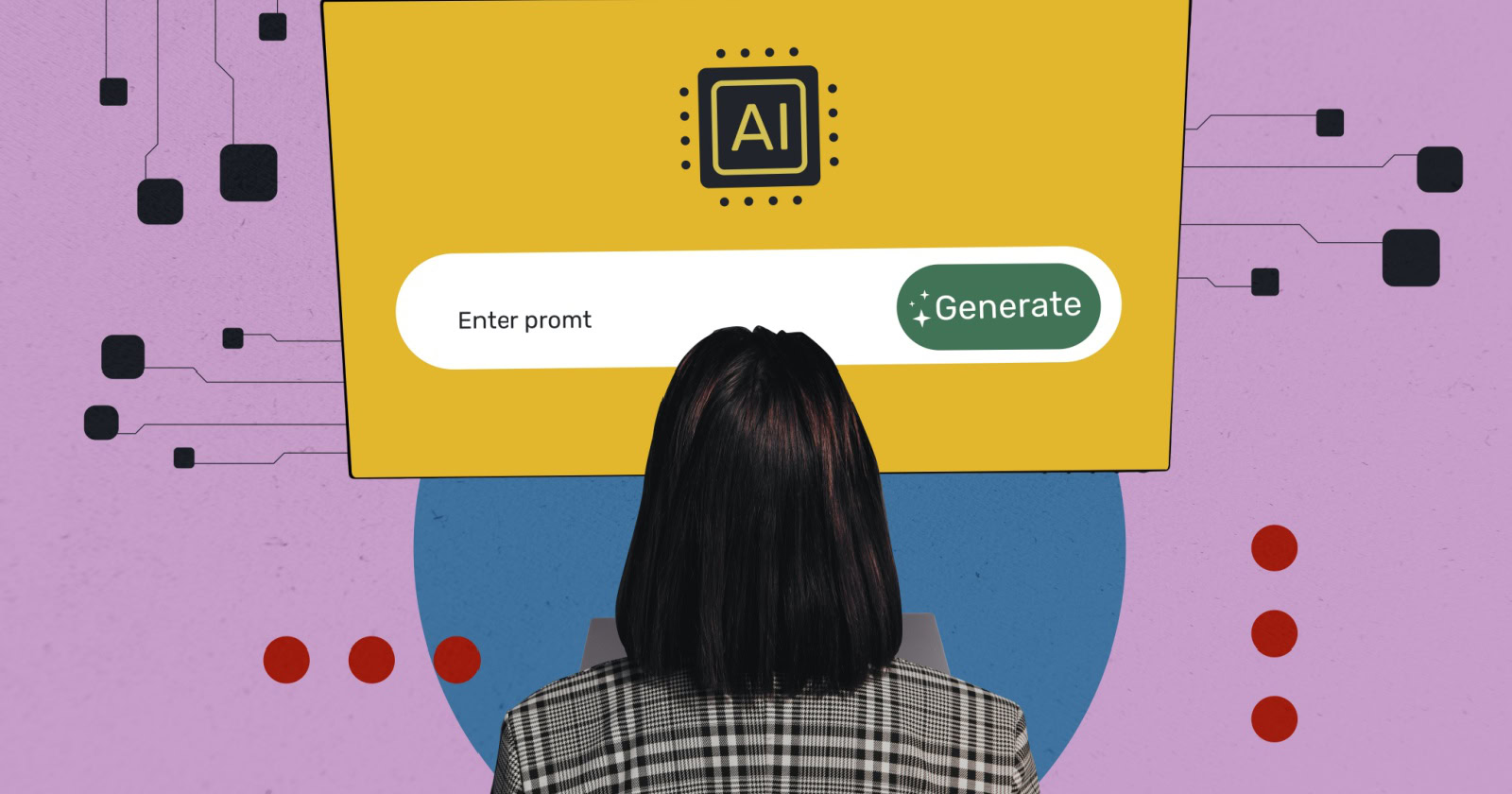Where is search going to develop? Is ChatGPT a threat or an opportunity? Is optimizing for large language models (LLMs) the same as optimizing for search engines? These are some of the critical questions that are top of mind for both SEOs and CMOs as we head into a multi-search world.
In Part 2 of this two-part interview series, I try to answer these questions based on data from our internal research to provide some clear direction and focus to help navigate considerable change. If you haven’t already, go back and read Part 1.
What you will learn in this Part 2:
- Traditional Search Engine Results Page (SERP) Evolution: Why traditional search isn’t dying but fundamentally transforming, where it still excels, and how it is part of Google’s integrated approach to AI evolution.
- Google AI Mode Strategy: How AI Mode and AI Overview operate as the same strategy at different thresholds, with AI Mode being 2.1x more likely to include brands while AI Overview remains highly selective.
- Agentic AI Revolution: Why 33% of organic searches now come from AI agents browsing on behalf of users, creating real-time interactions that demand immediate content accessibility.
- Search Funnel Transformation: How the customer journey has evolved from linear progression to unpredictable funnel-stage jumping, with AI handling research while conversion still happens through traditional organic channels.
- The Three Pillars Framework: Why CMOs need reporting for early AI shift detection, automation for seamless AI-readiness, and strategic recommendations to influence how AI tells their brand’s story.
Do You Think There Is Any Future For Traditional SERP Search, Or Do You Think It Will Become Obsolete?
I think we’re witnessing more of an evolution than an extinction. Traditional SERP search has a future, but it’s going to look completely different.
According to our internal data, 92% of all searches happen here. And when it comes to meaningful actions, such as downloads, sign-ups, or purchases, 95% start on Google. Search volume hasn’t gone down – it’s actually grown 10% year-over-year. With AI Mode, Google is layering AI directly into the experience.
The takeaway is clear: AI hasn’t replaced traditional SERPs; it’s utilizing and aligning with them.
 Image from author, September 2025
Image from author, September 2025Where Traditional Search Still Excels
Traditional search still absolutely shines in certain areas. When you’re dealing with complex queries or personal searches, those traditional SERPs still provide something AI cannot: depth, discernment, and diverse perspectives. Ecommerce is a perfect example – when shopping, I still want to see those traditional listings to compare sources, read different reviews, and check various offers.
Traditional SERP’s And Google’s Integrated Approach
Google is handling this integration cleverly. They’re not replacing classic SERPs; they’re augmenting them. Google’s Gemini model powers AI Overviews that appear above traditional listings, creating comprehensive summaries from multiple sources. Classic SERPs provide the foundational data, and AI distills and presents it in new, user-centric ways.
For brands and CMOs, this creates a new optimization challenge. You’re not just thinking about traditional SEO anymore; you need to optimize for AI inclusion, too. If you get cited in an AI summary, your visibility increases dramatically. It’s an interesting paradox where fewer traditional listings appear, but cited sources gain more prominence.
We’re seeing conversational capabilities, multimodal search with images and video, and direct answers that go way beyond static blue links. Users can now ask follow-up questions, search with photos, or engage in natural language conversations – capabilities that would have been impossible with traditional link-based results.
When AI Search Meets Traditional SEO
The overlap between AI citations and traditional search results has grown 22.3% since 2024. However, this varies significantly by industry, making your vertical a key factor in strategy development.
The variation is substantial. Ecommerce saw minimal change at 0.6 percentage points, while Education increased by 53.2 percentage points. Your industry determines the approach you should take.
In YMYL sectors like Healthcare, Insurance, and Education, overlap reaches 68-75%. When trust is critical, Google tends to favor content that already performs well in traditional search rankings.
Ecommerce operates differently. Overlap remained flat, and AI Overview coverage actually decreased by 7.6 percentage points. Google appears to maintain separation between shopping queries and AI answers, likely to preserve the transactional flow that drives commerce.
 Image from BrightEdge, September 2025
Image from BrightEdge, September 2025The Interconnected Search And AI Engine Ecosystem
What’s happening is that AI Overviews are acting as content curators, selecting which sources to reference and cite. This means your content needs to be clear, authoritative, and structured in ways that both humans and AI can easily understand and extract value from. The fundamentals of relevant content – quality, clarity, technical optimization – they’re more critical than ever.
The likes of ChatGPT and Perplexity tap into traditional search engines for factual grounding, so this interconnected ecosystem is becoming the norm. It’s not just about ranking on SERPs anymore; it’s about being discoverable across multiple channels: social search, AI interfaces, traditional SERPs, and whatever comes next.
The New Traditional CMO, SEO, And AI Reality
But those traditional foundations remain crucial – they just serve both humans and AI now. For straightforward, fact-based queries, AI can generate instant answers, removing the need to browse multiple results. But for anything complex, local, or transactional, those classic blue links still appear, sometimes as fallback options, or often as primary results depending on the query type.
However, it’s worth noting that AI Overview shares the screen with classic SERPs and ads. Still, your visibility may significantly increase when you get cited in an AI-generated summary, a paradox in which traditional results may decline, but referenced sources tend to become more prominent.
Keeping Pace With Change
The pace of change is also something CMOs need to prepare for. Google’s AI Mode is evolving incredibly quickly – features, user interface (UI) presentation, and citation logic change frequently. You need to invest in technology and teams that provide real-time insights into SERP and AI Mode visibility. Keep new AI entrants on your radar, and their experimentation and pilot projects, which are crucial for understanding what drives referenced visibility and conversions through AI sources.
 Source: BrightEdge report, September 2025
Source: BrightEdge report, September 2025The role of traditional SERPs is not dying. AI and traditional search work hand in hand; it’s now Google’s default approach, and both systems co-exist beautifully, serving diverse needs within the same search journey.
Learn More: Google Speculates If SEO ‘Is On A Dying Path’
What Do You Think CMOs Should Consider About How Google AI Mode Might Change An Enterprise Approach?
This is one of the most significant strategic shifts CMOs are facing right now, and it’s happening fast. Google’s AI Mode is fundamentally changing how enterprise visibility, engagement, and measurement work across search and discovery channels.
Understanding Google’s AI Strategy: AI Overviews And AI Mode
Our recent analysis reveals that AI Mode and AI Overview are not distinct strategies. They’re the same strategy but operating at different thresholds.
Think of it this way: AI Mode acts as the broad discovery engine. It’s 2.1x more likely to include brands (compared to AI Overviews), surfaces more unique brands overall, and maintains pretty stable week-over-week patterns. When it shows sources, you’ll see fewer but more prominent source cards. It’s casting a wide net with lower barriers to entry.
- AI Overview, on the other hand, is the dynamic curator. It’s much more selective – only including brands in 43% of responses – but shows significantly higher volatility, which tells us the algorithm is actively evolving.
- AI Mode provides stable, broad discovery, whereas AI Overviews are where Google tests new ranking approaches with much higher selectivity. It’s clever – they’re serving different user needs while continuously refining their AI capabilities.
The Multi-Query Reality Of Google AI Search
An AI query is never just one search anymore. AI Mode runs dozens of queries on behalf of the user before showing an answer.
That one question – “What’s a good treadmill for beginners?” – becomes dozens of searches instantly. Google breaks it down into features, price comparisons, reviews, safety tips, compact options, and warranty information. The AI runs these searches in parallel, pulls results, and stitches them together into a single conversational answer.
It’s no longer about matching one keyword. You’re competing to be included across the entire web of related questions that the AI asks on the user’s behalf.
AI Mode And Living In The Browser
Think about how much time you spend in your browser every day. Now imagine if it could actually think alongside you. That’s exactly what’s happening with Google Chrome’s latest AI features, and honestly, it’s pretty mind-blowing.
Here’s what’s new: AI Mode lets you ask complex questions right in the address bar – no more opening countless tabs just to find answers. Planning a trip? Chrome’s multi-tab intelligence can now pull information from all your open tabs and create one coherent plan. And soon, agentic browsing will let Gemini handle the boring stuff like booking appointments while you focus on what actually matters.
The cool thing is, AI Mode isn’t replacing Google – it’s just giving us a smarter way to use it. Think conversational search, but built right into where you already spend most of your time.
For CMOs and marketing teams, this means rethinking how people will find and interact with your content. We’re not just optimizing for search anymore; we’re optimizing for conversation.
The CMO Content Strategy And Keeping Pace With Change
Your content strategy needs a complete rethink. AI Mode pulls directly from content to generate overviews and summaries, which means you can’t just optimize for traditional SEO anymore. Your content needs to serve both AI and human audiences simultaneously. The goal is not just to rank anymore; it’s also to be selected for AI-generated overviews.
CMOs need to prepare for the pace of change. Google’s AI Mode is advancing at a rapid pace, with frequent shifts in features, UI presentation, and citation logic. You need to invest in tools and teams that provide real-time insights into SERP and AI Mode visibility.
How Are Agentic AI Agents (Crawlers And Bots) Changing The Search Funnel? How Might These Changes Impact Roles On The CMO And The SEO Team?
We’re seeing a major shift in how content gets discovered and delivered, as new types of AI agents engage with websites and surface information in real-time conversations. AI agents are now browsing on behalf of users. Unlike classic crawlers, it’s not about indexing pages to be served up later; it’s real-time interactions. If you have a dead page, or it can’t interpret what your content is saying, you lose that moment.
The Rise Of AI Agent Website Interaction
They’re acting like digital assistants – researching, comparing, recommending. If your page is slow, or your content isn’t clear, they move on instantly. They are your future customers – potential new clients – arriving through AI. In the last month, we’ve seen visits from ChatGPT’s new Agent crawler double in visits to customer websites. 33% of all organic searches are from these agents. The growth is massive.
The AI Agent Preprocessing Layer
This creates a preprocessing layer that influences every subsequent customer interaction. Unlike traditional crawlers that simply index content, these systems navigate websites, submit forms, compare options, and make recommendations on behalf of the user in real-time. Each visit represents AI doing a search on your customer’s behalf, looking for content to help explain, recommend, and help your customers in a conversation.
How This Impacts The Evolution Of The Customer Journey
The awareness phase has evolved from user-driven discovery to “pre-aware” algorithmic surfacing where AI agents proactively recommend options based on context, preferences, and behavioral patterns – often before users consciously realize they need information. Modern buyer behavior no longer follows a straight-line progression. Instead, customers jump between funnel stages unpredictably, sometimes moving directly from initial awareness to making purchases, or cycling back to discovery phases for related products.
- AI Search Users: Enter the funnel at the research and exploration stage, asking questions and gathering information to inform their decisions. They’re seeking understanding, not yet ready to transact.
- Organic Search Users: Demonstrate clearer purchase intent, often searching for specific products, services, or solutions. They know what they want and are closer to conversion.
- The Journey Dynamic: Many users begin with AI-powered research but ultimately convert through organic search or direct channels – making AI search valuable for top-of-funnel discovery despite its lack of direct conversions.
The Research Vs. Conversion Channel Reality
As AI search functions as a research channel, not a conversion channel, this confirms that AI systems are handling awareness and consideration stages, while conversion still requires traditional touchpoints. We found that 34% of AI citations come from PR-influenced sources and 10% from social platforms, demonstrating that traditional SEO concepts like E-E-A-T (Experience, Expertise, Authoritativeness, Trustworthiness) remain critical but must now work at machine scale across multiple platforms.
Immediate CMO Transformation Requirements
Foundation Strengthening: Companies must rapidly enhance SEO fundamentals – structured data, content authority, and technical excellence – that determine whether AI agents can find, understand, and cite their content. Brands not only need to keep the door open to agents, but they also need to embrace them, so they are not invisible to the AI agent processing layer I mentioned earlier.
New Measurement Frameworks: Marketing teams must develop new measurement frameworks that capture AI citation frequency, cross-platform visibility, and influence within AI responses, even when traffic attribution is impossible. Key metrics include brand visibility monitoring, AI presence testing, reference share analysis, and indirect conversion tracking.
CMO And Marketing Team Structure
The team structure evolution reflects a fundamental shift from departmentalized hierarchies to fluid, cross-functional pods. Technical teams become increasingly AI-augmented for scale, content teams shift from creation to curation and refinement, and new integration teams bridge SEO with data science and machine learning departments.
Concluding Thoughts: The CMO, SEO, And AI Reality Check
Here’s the critical takeaway: While you’re optimizing your funnel for AI discovery, remember that organic search is still where conversions happen. AI search serves as the research phase, helping users discover options and gather information.
But when they’re ready to take action – making a purchase, signing up, or downloading – they’re still turning to traditional organic search results. They recognize that AI discovery feeds into the organic funnel. Your SEO foundation becomes the conversion engine that AI discovery feeds into.
The smartest CMOs and marketers aren’t choosing between AI and organic search. They’re using proven SEO strategies as their foundation while adapting for AI discovery.
More Resources:
- Ex-Microsoft SEO Pioneer On Why AI’s Biggest Threat To SEO Isn’t What You Think
- Explaining Agentic SEO To The C-Level
- State Of SEO 2026
Featured Image: Roman Samborskyi/Shutterstock


